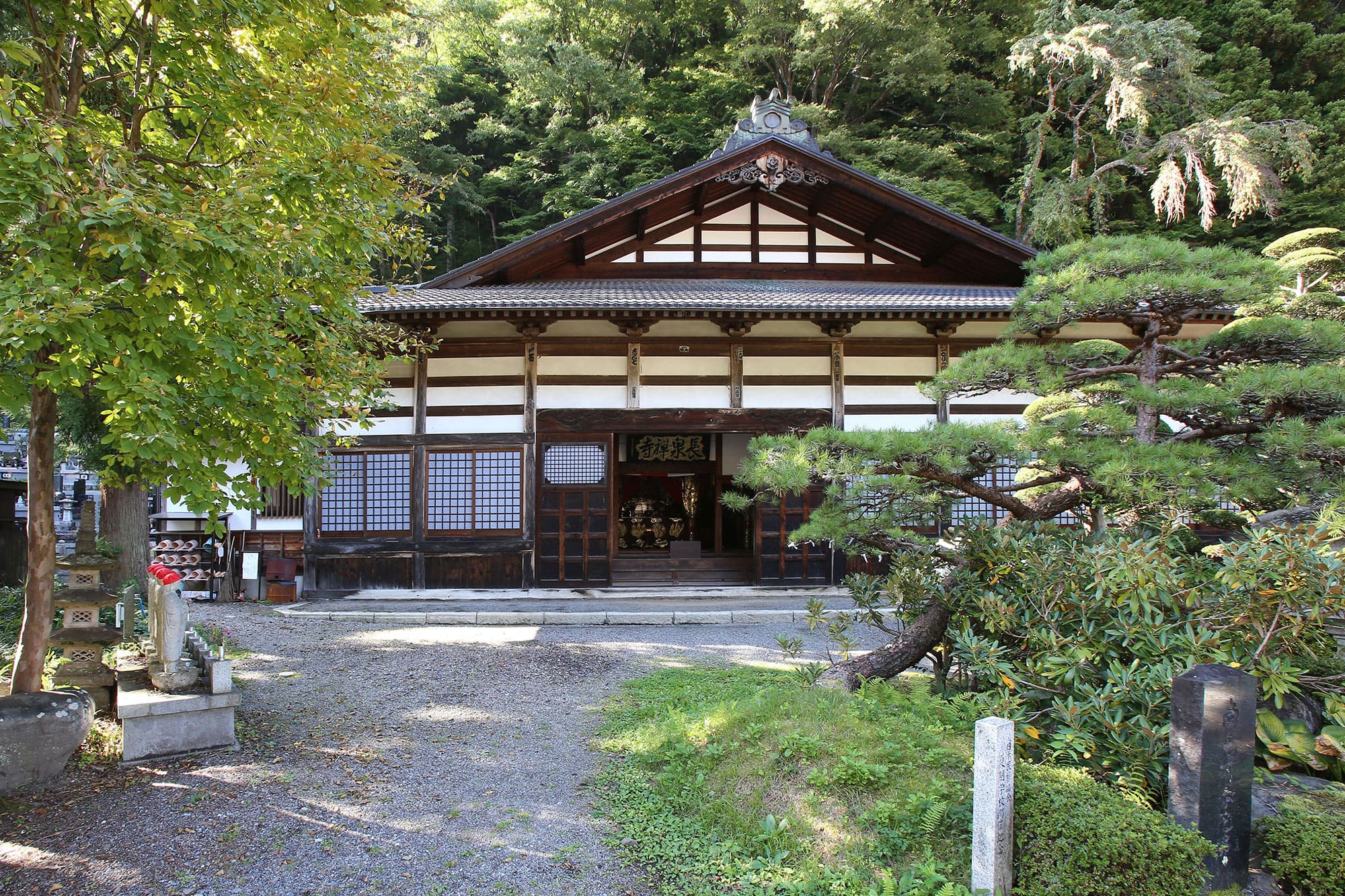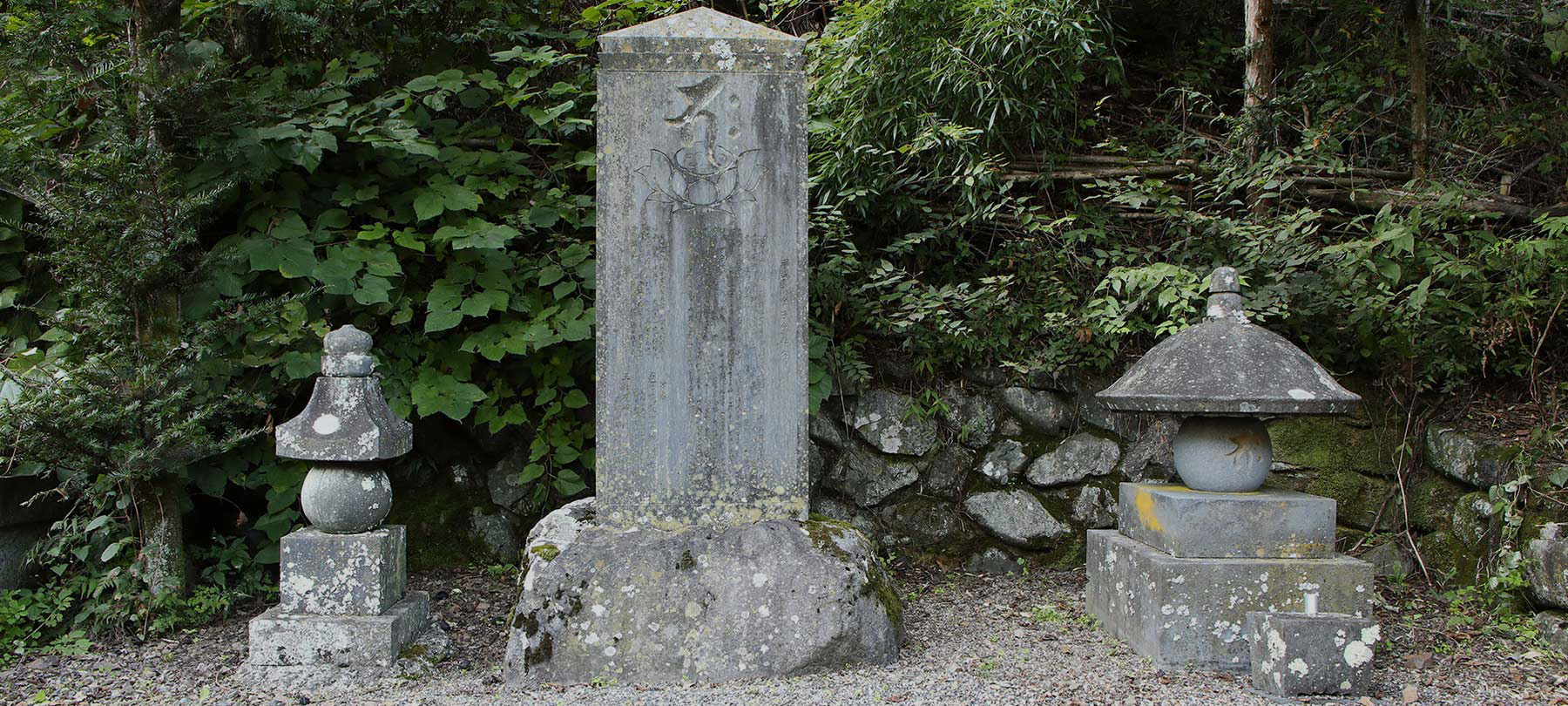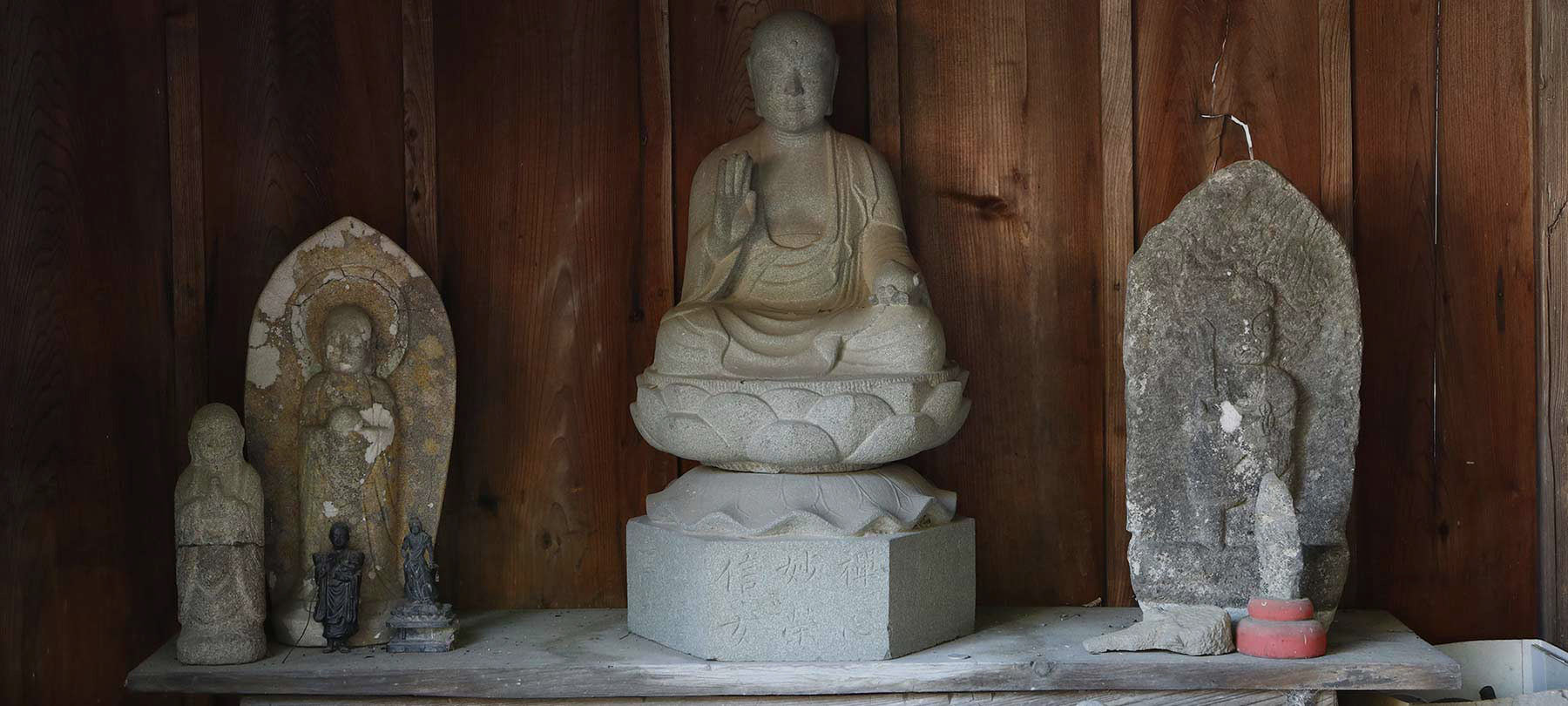

It is said that this temple was built in 1366 during the Nanbokucho period by Gensho Kihon Buddhist priest. In ancient times, it was called “Seigoji” and later became the Soto sect “Chosenji”. In the 10th year of Tensho (1582) during the Azuchi-Momoyama period, the building was destroyed by fire during the battle between Yoshimasa Kiso and Katsuyori Takeda. It was rebuilt in the first year of Bunroku (1592), but it has been rebuilt several times due to repeated relocations and fires, such as being burnt down again in the great fire of Tenpo in Narai in the late Edo period. The current main hall was built in 1866 at the end of the Edo period. The main gate was relocated as the gate of this temple when the main camp of Narai-juku was dismantled. The gables, thatched roofs, Ichinohe, and Yakui Gate are valuable remains that survived the great fire.

The “Dragon’s Great Ceiling Painting” in the main hall was drawn by Hida’s master, Gonnomasa Yamaguchi (Yamaguchi Gon no Kami) since the Meiji era. “Masa” is read as “Kami” and is the official name allowed for the excellent master of Hida’s master. In addition to this, Gonnomasa Yamaguchi has left many works in Nagano prefecture.
The size of the ceiling painting is about 20m in lwngth and 3.5m in width. The dragon is a Buddhist priest and is said to watch over the monks. It is also the god of water and has the meaning of protecting the building from fire. Until the latter half of the Showa period, it was called “Singing Dragon”, and when you clap your hands under the eyes of the dragon, the mechanism in your eyes echoed and you could hear a unique sound. But now, unfortunately, the sound is no longer heard, probably because the entire building is aging.
The Palanguin hanging from the ceiling near the window of the main hall was actually used at the end of the Edo period. The samurai of the Satsuma domain, Nananosuke Fukusaki, was on board. Fukusaki was an aide to Shimazu Nariakira, the lord of the Satsuma domain, but in 1853, he died of illnwss during his stay in Narai and was buried in the temple at the forerunner of the Daumyo procession from Edo to the Satsuma domain.

During the Edo period, the procession in which the shogunate packed Kyoto Uji tea for the shogun into a tea jars and carried it to Edo Castle was called “tea leaf jar Dochu” or “Uji tea leaf jar Dochu”. This procession, which was institutionalized in the era of the third shogun Iemitsu in 1633 and continued until the end of the Tokugawa shogunate, was a procession to inform the authority of the shogun. The absolute authority of “general use” was given, and if any daimyo met during the teapot road, he was supposed to give priority to this procession at the end of the road.
The group that departed from Uji passed through Nakasendo, and at Narai-juku, this Chosenji temple was used as an accommodation. There is a record in the temple that “onyado (*) should be used when traveling along the teapot,” and Onyado was one of the temple’s jobs. Even during the busy farming season, the highways along which the procession runs were banned from working in the fields, and children were not allowed to enter or leave the doorways or smoke from boiling. The common people along the road were afraid of this prestigious procession, and when the procession of tea pots came, they closed the door and shut themselves up in the house. The situation is expressed in the nursery rhyme “Zuizu Izukurobashi”.
The actual tea pot that was carried in the Edo period still exists at this temple. I’m not sure if it’s a refrain from an accident during the trip or a tribute to the temple that I’m staying at every year.
On the final day of the Narai-juku Festival, which is held in June every year, a procession that reproduces the way of the tea-reaf jar departs from Chosenji Temple from noon and goes around the Naraijuku.
※Providing accommodation with respect for the guests

Nobuyoshi Fujita, who was a powerful family in Musashi Province, changed his lord to the Hojo clan, Takeda clan, and Uesugi clan according to the tradition of the Warring States period, and finally became the Tokugawa daimyo. is.
He served as Numata Castle under Mr. Hojo, but since his relatives died a mysterious death that seems to be due to Mr. Hojo’s plot, he accepted Masayuki Sanada’s plan and surrendered Numata Castle, Takeda. I came to serve Katsuyori. Then, given the Takeda family’s character, “Shin,” he welcomes Shingen Takeda’s granddaughter as his wife.
In the 10th year of Tensho (1582), in the battle between Katsuyori Takeda and Yoshimasa Kiso at the Torii Pass, Narai was also struck by fire and Chosenji was destroyed by fire. Nobuyoshi, who was devoted to Osho Yamato, the chief priest of Chosenji Temple, later revived the temple’s sangharama. It became the foundation of Chuko Kaiki.
After the fall of the Takeda clan, he served the Uesugi clan in Echigo and played an active part in various battles, and was ranked fifth in the ranking of the Uesugi clan after Kanetsugu Naoe. After the death of Toyotomi Hideyoshi, Tokugawa Ieyasu’s solo run became conspicuous, but Kagekatsu Uesugi and Kanetsugu Naoe did not change their minds to reward the late Hideyoshi’s treatment and showed their willingness to resist Ieyasu.
In the New Year of Keicho 5 (1600), Nobuyoshi went up to Osaka on behalf of the scenic spot and greeted Hideyori Toyotomi and Ieyasu Tokugawa for the New Year. At that time, Ieyasu is said to have said, “Tell me that Ieyasu should go up and discuss national affairs together.” In order to avoid unnecessary wars and protect the people, and to protect the Uesugi family, Nobuyoshi recommended reconciliation with Tokugawa, but Kagekatsu and Kanetsugu will continue to go through the war. Around this time, the wind on Nobuyoshi on the peace line became stronger, and he was removed from the forefront of the Uesugi Corps. In addition, because there were rumors that Kanetsugu was aiming for his life, he left Aizu with the clan party, leaving a letter of invocation saying that the Uesugi family had no two hearts. After that, I shaved my hair at Daitokuji Temple in Kyoto and lived there. At the time of the conquest of Aizu, which triggered the Battle of Sekigahara, Ieyasu ordered directions, but he resigned, saying, “The Uesugi family has no two hearts.” Later, Ieyasu repeatedly called out to serve Tokugawa, and Nobuyoshi, who was defeated, became the daimyo of Shimono Nishikataban 15,000 stones. It is said that Ieyasu found utility value in Nobuyoshi’s relationship with Takeda, Sanada, and Uesugi, and also bought the ability as a tactician and a castle builder.
He joined the winter and summer camps in Osaka, and suffered a great deal of damage in the summer camp, so he asked the shogunate to take a bath and healed at Shinshu Suwa Onsen. However, the wound was unexpectedly heavy, and he was buried at Chosenji Temple in Narai at the end. Nobuyoshi’s legal name is “Jikishiin-den Ichihiki Genshin-shi”. Since he left a will to the priest of the temple to call himself “Fujita”, his last name, the chief priests who entered Chosenji kept giving their surname Fujita until the Meiji era.
* Reference materials “Old Temple Documents / Others” “Nobuyoshi Fujita Notomori (Heiji Shimura / Rekishigaku Kenkyusho)” “Mr. Kitakami and Mr. Fujita Musashi (Motoki Kuroda / Naomi Asakura / Iwata Shoin)” “Mr. Uesugi Chronology (Susumu Ike, Toshifumi Yada ed./Koshishoin) “

In the Edo period, the masons of the Takato clan (currently Ina City), who were called “Takato Stonemasons” and were famous all over the country, have excellent skills and go to various places to make various stone masons. I did.
Among them, Sadaji Moriya (1765-1832) was called a rare master craftsman. Sadaji’s works are located all over the prefecture, and he has left more than 300 works in his lifetime. Which is said to be the most beautiful figure in Kiso Valley.